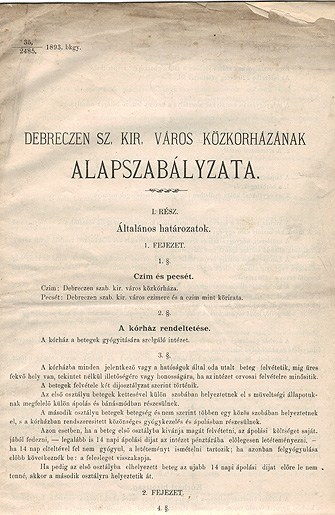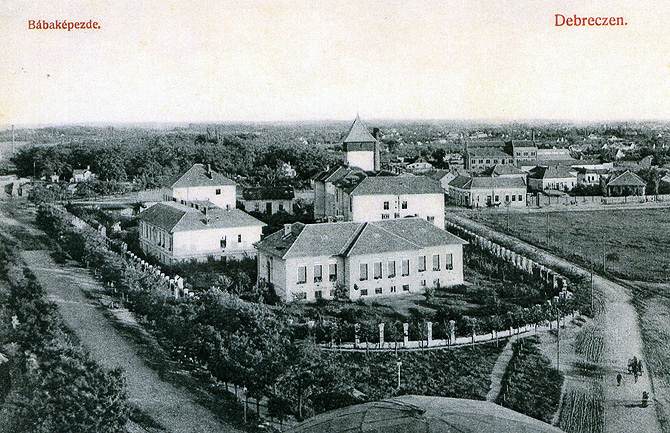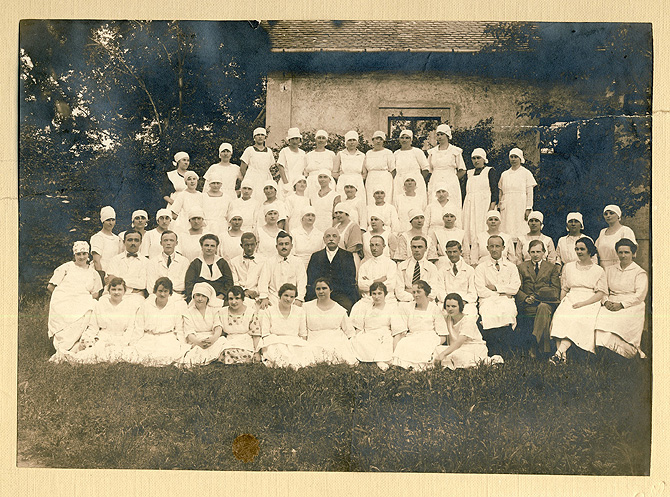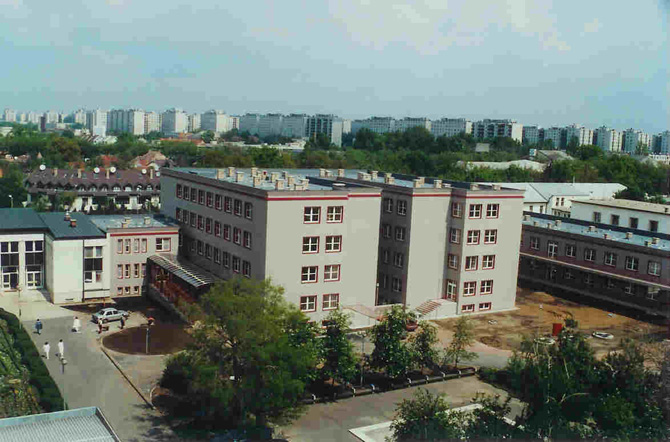From “Ispotály” to Modern Hospital
Debrecen’s public welfare institution, which was called Ispotály [an archaic version of hospital in Hungarian] and which had been established as one of the earliest poorhouses in the world, was already operating in the 16th century. The house, which was operated in line with contemporary general requirements and conditions was founded in 1529 by László Boncz, an eminent citizen of Debrecen. The needy and dependent elderly and unemployed persons in Debrecen were provided shelter in the buildings located in Csapó Street and in the neighboring chapel called Szent Erzsébet-kápolna. Supported by the municipal authority, Ispotály continued to operate at this location until 1552. When a cloister situated nearby in the same street was left by the Franciscan friars after the general embracement of Reformation in Debrecen, it was moved and continued to function there until 1704 and was identified as inner Ispotály. However, this arrangement proved to be insufficient later on and, as a consequence, an additional, outer Ispotály was established south of the town moat in 1553 with the support of the Reformed Church and the municipal authorities.
A significant step in the healthcare development of our city in the 17th century involved the inauguration of a pharmacy with the name Arany Angyal [verbatim: Golden Angel]. It was sustained by the city and, in 1717, even a pharmacy official was appointed to supervise its operation.
In 1715, physician Fülöp Fáber was elected the first surgeon general of the town of Debrecen. According to contemporary records, there were several citizens in the town with qualifications enabling them to be involved in curing and healing people. Most of these individuals had been former students of the Reformed College of Debrecen and they learned about or acquired a knowledge in medicine during their studies abroad, which some of them even practiced after their return home. Despite their availability, most of the tasks related to providing healthcare for the town fell under the responsibility of the members of the local barber-surgeon guild. One of the best-known master-surgeons among them was the father of the poet Mihály Csokonai Vitéz.
Debrecen and its citizens seem to have struggled with three arch adversaries continuously and recurrently: physical attacks by actual enemies, outbreaks of fire, and epidemics.
The first occurrence of the plague and the consequent major wave of epidemic dates back to 1739. The 1831 cholera outbreak was so serious that, in one single week, as many as 2,152 citizens of Debrecen died. After the raging of the contagion abated, the hurriedly established temporary hospitals were closed down, with the exception of one, which was located in an old dilapidated building, formerly used by the tobacco industry. This then became the first civilian hospital of Debrecen, with care provided on 12 beds.
At the beginning of the 1840s, which was a decade witnessing the rise of the modern middle class, the town council started to consider a plan to construct a building for a hospital that would meet the current standards and would be located outside the contemporary city limits in a large and spacious area. The committee formed for this purpose picked a sizable stretch of land beyond Péterfiai kapu [Péterfiai Gate], at the intersection of Nagyerdei and Hadházi streets. Although this was the same location where a higher school of economics was indeed built in the meanwhile, the public hospital was finally accommodated there, too, 50 years later.
 This multiple-pavilion hospital, which was a contemporary state-of-the-art institution, contained several individual divisions, including wards for internal medicine, syphilis, surgery, midwifery, ophthalmology, psychiatry and infectious diseases.
This multiple-pavilion hospital, which was a contemporary state-of-the-art institution, contained several individual divisions, including wards for internal medicine, syphilis, surgery, midwifery, ophthalmology, psychiatry and infectious diseases.
However, just like at any other time in history, evolution and progress did not halt.
The forerunner of the University of Debrecen was Debrecen’s Reformed College, which is more than 475 years old now. The management of this institution, which was awarded college status at the end of the 19th century, kept trying to elevate their rank to that of a university. However, this did not seem possible until 1911, at which point the college offered programs in theology, law and humanities. In order to be granted university status, it was also necessary to offer courses in medicine but, without a proper hospital or clinic, this seemed a mission impossible. At that time, in addition to the public hospital at Bem Square, there was only a school for midwifery, and the then newly built Auguszta Tuberculosis Sanatorium operating in Debrecen. However, these three institutions, located at three different sites, were not suitable for providing high-quality education in healthcare, so the construction of a modern clinical section was necessary for the future university.
Thus, as early as 1906, the municipal government commissioned Gyula Kenézy, one of the most excellent physicians of the time and the director of the school of midwifery to form a preparatory committee for the establishment of a university.
 It was in 1912 that an act was finally enacted about the prospective university, and Kenézy, who was nominated to the position of government commissioner, made sure that the designer of the building complex, Flóris Korb, would first complete the section that was to incorporate the clinics. Eventually, in March 1914, just two months before the outbreak of the First World War, the actual construction work could be started.
It was in 1912 that an act was finally enacted about the prospective university, and Kenézy, who was nominated to the position of government commissioner, made sure that the designer of the building complex, Flóris Korb, would first complete the section that was to incorporate the clinics. Eventually, in March 1914, just two months before the outbreak of the First World War, the actual construction work could be started.
Although the university was far from being fully completed on October 23, 1918, an official inauguration was held on that day with King Charles IV of Hungary and Queen Zita present for the occasion. The remaining buildings of the clinics were only completed by 1927, while the central building of the university was ultimately presented to the citizens of Debrecen as late as 1933. (Unfortunately, Kenézy did not live to see this, as he passed away due to a serious illness and a family tragedy.)
As for the public hospital, arrangements and alterations were made in it during the summer of 1921 in order to accommodate the university wards, following which the reception of patients was started at the individual departments. As of October 1921, the public hospital of Debrecen ceased to function as such.
 The entire hospital site, together with all the medical equipment therein, was consequently given to the medical university by the municipal government. Nevertheless, less than seven years following this, the university council returned the operation rights of the public hospital located at Bem Square to the local government of the city.
The entire hospital site, together with all the medical equipment therein, was consequently given to the medical university by the municipal government. Nevertheless, less than seven years following this, the university council returned the operation rights of the public hospital located at Bem Square to the local government of the city.
In 1929, negotiations were conducted about the nationalization of the public hospital, which was then implemented in 1930. In 1932, the Ministry of Religion and Public Education issued a decree according to which the public hospital, which had been renamed in the meanwhile to Miklós Horthy Public Hospital, was to be put under the supervision of the István Tisza University of Debrecen. With this move, it seemed that Debrecen’s public hospital would disappear forever after a hundred years of its existence.
However, the hospital did not, in fact, cease to exist. What is more, it actively participated in healing and treating the ill and the injured even during the course of the Second World War, amid all the suffering and pain inflicted upon Debrecen and Hungary as a whole. After the war, it functioned as a post-war treatment and rehabilitation facility, starting to operate in the Diakonissza building in 1946 as an interim location until the Soviet military headquarters decided to leave the buildings they had occupied on Bem Square to return them to the city authorities. In terms of the availability of professional equipment, the situation was devastating: almost all devices for healing and related treatments had been lost during the war.
As early as January 1947, the hospital was back to business as usual on Bem Square, a venue that could treat 16 to 18 patients at a time in the building that included a department of neurology. Following its reconstruction in 1950, the hospital, which was still owned by the state but already operated by the Debrecen City Council, had as many as 295 beds for patients. On January 1, 1951, the Ministry of Health also added a 50-bed maternity ward to it, formerly run by the South Hungarian Cultural Union (DMKE). The hospital was also expanded later to incorporate the building on the corner of the Bartók Béla and Pesti streets.
 Major developments and investments in the hospital were launched in the 1970s, including the establishment of diagnostic and surgery units in the section next to Dorottya Street, as well as the later additions of the psychiatric department and the division of infectious diseases in the 1990s.
Major developments and investments in the hospital were launched in the 1970s, including the establishment of diagnostic and surgery units in the section next to Dorottya Street, as well as the later additions of the psychiatric department and the division of infectious diseases in the 1990s.
Yet even before these latter developments, 1987 proved to be a significant turning point in the history of the institution, which was already named Hajdú-Bihar County Hospital and Clinic at that time. An official grand opening and inauguration ceremony was held for the new diagnostics building at Dorottya Street, and the institution was named after Gyula Kenézy.
Following this, the Gyula Kenézy Hospital and Clinic became one of the largest and most modern healthcare facilities in Hungary. The reform of healthcare financing in 2006 and the reduction of the number of hospital beds in 2007, together with the fact that it failed to receive regional status among hospitals, forced the County Government of Hajdú-Bihar County, its owner and operator, to make fundamental and responsible decisions. For this reason, the General Assembly founded two Ltd-s in 100% municipal government ownership on July 1, 2007, in order to transform the institution into a business corporation and to ensure the coverage of specific healthcare responsibilities. The starting date for the operation of both Kenézy Kórház Rendelőintézet Egészségügyi Szolgáltató Kft. [Kenézy Hospital-Clinic Healthcare Service Provider Ltd.] (or Kenézy Kórház Kft. for short) and Megyei Egészségügyi Vagyonkezelő és Ingatlanhasznosító Kft. [County Healthcare Asset and Property Management Ltd.] (or Megyei Egészségügyi Kft. for short) was December 1, 2007.
As of January 1, 2010, Kenézy Kórház Kft. was transformed into a nonprofit business corporation, and the official name of the company has been changed, too.
Its new name was Kenézy Kórház Rendelőintézet Egészségügyi Szolgáltató Nonprofit Korlátolt Felelősségű Társaság, or Kenézy Kórház Nonprofit Kft. for short.
In April 2013, roughly a year after the institutions providing hospital in-patient services came under state ownership, there was yet another turning point in the transformation of the national healthcare system. The healthcare institutions that had been under state supervision since 2012 were operated in a variety of forms (but most often as budgetary institutions or business corporations), as the former owners of healthcare institutions, which were the local governments at settlement and county level, could choose which form of healthcare provision they wished to organize under their authority.
In March 2013, the Hungarian Parliament passed a bill that was later announced as an act, which prescribed a compulsory form of operation for specific healthcare service providers. According to this act, hospitals, certain outpatient institutions and other organizations that operate them or provide infrastructural background for their operation and which had been put under state supervision and control in 2012, were to continue to work in a different organizational framework. Consequently, these business corporations ceased to operate, and their role was taken over by a newly established central budgetary body.
In Debrecen, the above transformation concerned a total of six business corporations, out of which three were healthcare service providers. Kenézy Kórház Nonprofit Kft., Egészségügyi Járóbeteg Központ Nonprofit Kft., and Nagyerdei Gyógyászati Kft., which all belonged to the group Egészségügyi Háttérszolgáltató Zrt., ceased to operate together with the mother company and two other asset management companies as of April 1, 2013. Their tasks and responsibilities were taken over by one single budgetary organization, Kenézy Gyula Hospital and Clinic.
In addition to taking care of the tasks and responsibilities of the former businesses, the new budgetary institution also became their legal successor. However, this transformation did not have a general effect on legal successorship, as the assets and certain legal transactions of the business corporations were taken over by the Hungarian state. As regards the management and operation functions of the hospital, these were divided between the Minister of Human Capacities and National Institute for Quality- and Organizational Development in Healthcare and Medicine.
The peculiarity of the situation of the service providers in Debrecen derives from the fact that the new budgetary institution took over the tasks and responsibilities of several individual healthcare service providers at the same time, and these had been working in a number of different areas on a variety of different tasks. Thus, a new institution was established that now represents an extraordinarily broad medical profile and provides its services at several sites across the city of Debrecen. Owing to the former structure of the group of business corporations, these healthcare institutions had been in close cooperation with one another before, and their activities had also been familiar to their former partners. As a consequence, a relatively quick transformation could be implemented without any significant obstacles and it did not in effect endanger the continuity and safety of patient care.
Due to the transformation, the review and screening of the complex structure of the three, formerly independent institutions that used to provide healthcare services also became necessary, along with the establishment of a rationalized internal institutional network which, just like before, could continue to provide high-quality, flexible, efficient and effective patient care.